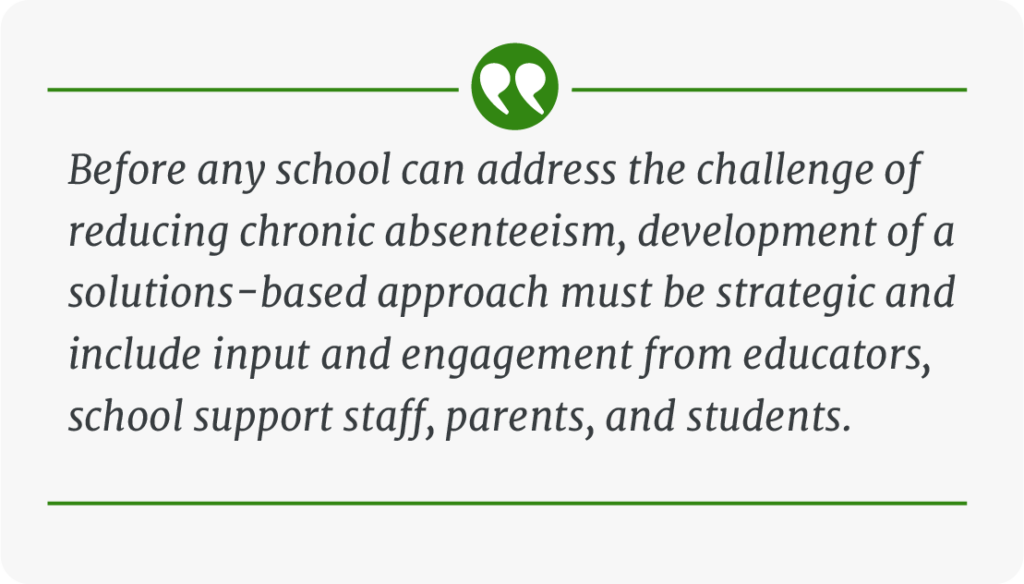by Karen Baptiste
Chronic absenteeism is on the rise across school districts in the United States, and schools are struggling to find tangible solutions to reverse this trend. According to a recent NPR report, research by Attendance Works found that prior to the pandemic 8 million students in the United States were considered chronically absent (i.e., missing 10% or more days in a school year). But since the re-opening of schools post Covid, absenteeism has risen significantly with 16 million students now chronically absent. Multiple research studies confirm that this level of absenteeism negatively impacts students’ academic achievement, wellness, and their trajectory in school.1,2,3
Some of the contributing factors to chronic absences include students’ health concerns, lack of transportation, or housing insecurity. Before any school can address the challenge of reducing chronic absenteeism, development of a solutions-based approach must be strategic and include input and engagement from educators, school support staff, parents, and students. While this is a rising issue across the country, there are strategies that schools and districts can employ to address chronic absenteeism.
Exploring Root Causes
Spend time together exploring and uncovering the root causes of your students’ absenteeism to better understand their specific contexts, challenges, and needs. Surveying stakeholders or hosting town hall meetings is a great way to start off a school year to find out what challenges students and families may be facing. Also, consider designating a team to conduct outreach to families when a student is absent to learn more about why the student is missing school. Having a team dedicated to communicating with families can help reveal issues including academic, social, or emotional challenges that may not always be apparent in a classroom, allowing for more targeted support and solutions.
Implementation Strategies
Once the root causes related to absenteeism have been identified,  ensure the actions you put into place to improve attendance are aligned to the students’ and families’ true needs and situations. Establish clear roles and responsibilities that allow all stakeholders to understand how they can support students and families to make decisions and/or find resources that are conducive to daily school attendance. While your school’s specific approach may vary, here are some general considerations that many schools have found helpful:
ensure the actions you put into place to improve attendance are aligned to the students’ and families’ true needs and situations. Establish clear roles and responsibilities that allow all stakeholders to understand how they can support students and families to make decisions and/or find resources that are conducive to daily school attendance. While your school’s specific approach may vary, here are some general considerations that many schools have found helpful:
- Building positive relationships between school staff and students and their families can be lifesaving for many students. This strategy will be more effective if staff are trained on how to show empathy, build trust, and make students feel safe and comfortable in school. Here’s a resource to help your school team strengthen relationships and trust with families. Working with families to support them in various ways to address their challenges can encourage students to attend school regularly. Relationship building isn’t easy, and it can’t be used as a panacea to solve every school issue; however, when a student knows you care for them deeply, they often will live up to your expectations and want to perform better because they value your opinion and support.
- Set realistic goals with students and families so that the change of behavior becomes innate and not focused on an incentive. Research studies show that when an incentive was used as a motivator, it did not have an impact on reducing absences. But when the school communicated with the student’s family about barriers and beliefs around attending school, it had a small impact on reducing absenteeism. Creating pathways of communication with students and families before a problem presents itself can create a space of trust for everyone to share their beliefs and express their needs. For example, in the beginning of the school year, send home an interest inventory survey to understand what the student and caregivers’ expectations are, including learning about their likes, dislikes, interests, and challenges, even if those are not directly connected to school.
- Use the feedback you’ve collected from students and their caregivers about their beliefs and needs around absenteeism to create a hub of resources that can be shared with families at the beginning of the school year. This can help build trust with students and families by modeling that the school is a wraparound resource that goes beyond teaching and learning to support the needs of the whole child. Free resources are often best because they remove the burden or stigma of financial output that is often placed on families when they don’t have access. For example, compile a list of local resources, community businesses (including churches and food pantries), and even other parents who may be able to provide time or resources to support families in the school who are struggling.
Being proactive and thoughtfully addressing root causes of chronic absenteeism can support students and their families to experience success. Involving all stakeholders is a multi-faceted approach that gives people a choice and an opportunity to be heard. When people are empowered to be part of the solution to their challenges, they are more likely to commit, especially when they know they have a community of supporters helping them along the way.
References
1 Gottfried, M. A. (2014). Chronic absenteeism and its effects on students’ academic and socioemotional outcomes. Journal of Education for Students Placed at Risk, 19(2), 53–75. https://doi.org/10.1080/10824669.2014.962696
2 Gershenson, S., Jacknowitz, A., & Brannegan, A. (2017). Are student absences worth the worry in U.S. primary schools? Education Finance and Policy, 12(2): 137–165. https://doi.org/10.1162/EDFP_a_00207
3 Liu, J., Lee, M., & Gershenson, S. (2021). The short- and long-run impacts of secondary school absences. Journal of Public Economics, 199. https://doi.org/10.1016/j.jpubeco.2021.104441
Karen Baptiste Ed.D. is a senior consultant at McREL International and a former special education teacher, instructional coach, and director who now works with K–12 schools across the U.S. to support improved teaching and learning with an emphasis on quality implementation of evidence-based instructional strategies for diverse learners, including helping teachers create learning environments that encourage student voice and ownership of learning. She is a co-author of The New Classroom Instruction That Works.

